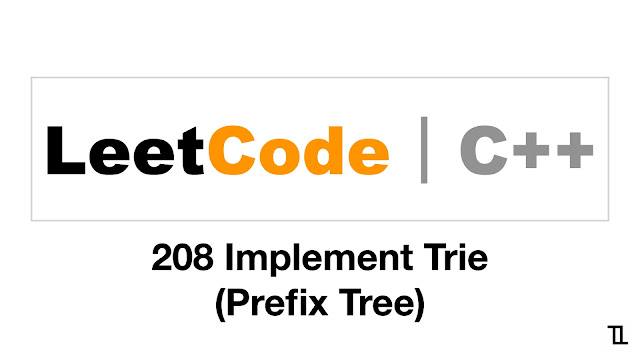簡介:中等,題意為實作Trie (prefix tree 前綴樹),可以使用Linked list, map, set去實作。
一、Linked list
(一)結構

|
|
用Linked list建構的trie,其紀錄abc和abde兩字。 |
上圖為用linked list建構的trie,每一個節點有兩個資料,分別為:
- isRecorded:這個字是否被紀錄,如:abc和abde有被記錄,但ab沒被記錄。
- children:一個指向節點的26格陣列,每一格代表一個英文字母,如果指向NULL,則代表此字母沒有被紀錄;如果有指向節點,則代表此字母有被紀錄。
以下為程式碼:
class TrieNode {
public:
bool isRecorded;
std::vector<TrieNode*> children;
TrieNode()
:isRecorded(false),
children(std::vector (26, NULL)){}
};
class Trie {
public:
TrieNode* root;
Trie():root(new TrieNode()){}
void insert(std::string word);
bool search(std::string word);
bool startsWith(std::string prefix);
};
(二)插入字詞
void Trie::insert(std::string word) {
TrieNode* node = root;
for (auto w : word) {
const int index = w - 'a';
// If the node have not a corresponding child, add a new child to it.
if (node->children[index] == NULL) {node->children[index] = new TrieNode();}
// Move to the next node
node = node->children[index];
}
node->isRecorded = true;
}
以上是insert()程式碼,時間複雜度為字詞 (word)長度。
- Line 3 for loop:只要把字詞的每一個字母依照順序和trie做比較即可。
- Line 6:如果此字母指向NULL,就讓他指向一個新節點。
- Line 8:移至下一個節點。
- Line 10:比較結束後,更新isRecorded為true。
(三)搜尋字詞
bool Trie::search(std::string word) {
TrieNode* node = root;
for (auto w : word) {
const int index = w - 'a';
// If the node have not a corresponding child, the trie does not store the word.
if (node->children[index] == NULL) {return false;}
// Move to the next node
node = node->children[index];
}
return node->isRecorded;
}
以上是search()程式碼,時間複雜度為字詞 (word)長度。搜尋的邏輯和插入很像,都要每個字母和trie做比較,比較不同的部分為:
- Line 6:如果此字母指向NULL,就直接回傳false,因為此字母沒有被記錄。
- Line 10:比較結束後,直接回傳isRecorded。
(四)搜尋前綴
bool Trie::startsWith(std::string prefix) {
TrieNode* node = root;
for (auto p : prefix) {
const int index = p - 'a';
// If the node have not a corresponding child, the trie does not store the prefiex.
if (node->children[index] == NULL) {return false;}
// Move to the next node
node = node->children[index];
}
return true;
}
以上是startWith()程式碼,時間複雜度為字詞 (word)長度。搜尋前綴和字詞的邏輯一樣,只不過在Line10中,直接回傳true。
二、Map and set
(一)Map

|
| 用map建構的trie,其紀錄abc和abde兩字。 |
上圖為用linked list建構的trie,這裡使用兩個Map分別去紀錄前綴 (prefix)與字詞 (word),以下為程式碼。
class TrieMap {
public:
std::map<std::string, bool> prefixMap;
std::map<std::string, bool> wordMap;
TrieMap(){}
void insert(std::string word);
bool search(std::string word);
bool startsWith(std::string prefix);
};
void TrieMap::insert(std::string word) {
// Store word
wordMap[word] = true;
// Store prefix
string key = "";
for (int i = 0; i < word.size(); ++i) {
key += word[i];
prefixMap[key] = true;
}
}
bool TrieMap::search(std::string word) {
return wordMap[word];
}
bool TrieMap::startsWith(std::string prefix) {
return prefixMap[prefix];
}
插入有兩部分:
- Word:直接加入字詞,時間複雜度為 log(字詞總數)。
- Prefix:每個前綴依序加入,時間複雜度為 字綴長度*log(前綴總數)。
搜尋字詞與前綴就直接回傳map即可,如果不在map裡的字,operator[]會將此字加入map中,並給予false。
(二)Set
在Map中,我們使用兩個map去紀錄word和prefix,但事實上我們只需要wordMap即可。然後你應該會發現,map紀錄的true很冗餘吧?所以我們也不用map,只要set就好。實作如下:
class TrieSet {
public:
std::set<std::string> strSet;
TrieSet(){}
void insert(std::string word);
bool search(std::string word);
bool startsWith(std::string prefix);
};
void TrieSet::insert(std::string word) {
strSet.insert(word);
}
bool TrieSet::search(std::string word) {
return strSet.find(word) != strSet.end();
}
bool TrieSet::startsWith(std::string prefix) {
auto it = strSet.lower_bound(prefix);
if (it == strSet.end()) {return false;}
for (size_t i = 0; i < prefix.size(); ++i) {
if (prefix[i] != (*it)[i]) {return false;}
}
return true;
}
插入就直接把字詞放入集合中,而搜尋字詞就在集合中搜尋此字即可。最後搜尋前綴就要利用lower_bound()去找出和字詞最像的元素出來,然後比較這兩前綴是否一致?
三、相關文章
請詳見LeetCode相關文章

留言
張貼留言